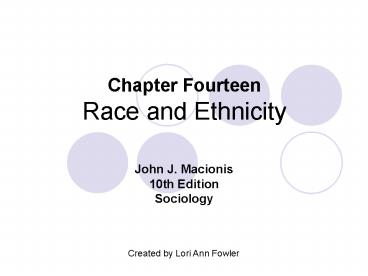Chapter Fourteen Race and Ethnicity - PowerPoint PPT Presentation
1 / 21
Title: Chapter Fourteen Race and Ethnicity
1
Chapter FourteenRace and Ethnicity
- John J. Macionis 10th EditionSociology
Created by Lori Ann Fowler
2
The Social Meaning of Race and Ethnicity
- Race a socially constructed category composed
of people who share biologically transmitted
traits that members of a society consider
important. - Ethnicity a shared cultural heritage.
- Race involves highlighting biological traits.
- Ethnicity involves highlighting cultural traits.
3
Table 14-1 Racial and Ethnic Categories In the
United States 2000
4
Minorities
- A minority any category of people,
distinguished by physical or cultural difference,
that a society sets apart and subordinates. - Minorities have two major characteristics
- (1) They share a distinctive identity.
- (2) Subordination
5
National Map 14-1 Where the Minority-Majority
Already Exists
6
Prejudice
- Prejudice a rigid and irrational generalization
about an entire category of people. - Prejudgments that are positive or negative.
- They lead us to characterize all members of an
entire group, most of whom weve never met.
7
Stereotypes and Racism
- Stereotypes an exaggerated description applied
to every person in some category. - Both the majority group and minorities hold
stereotypical beliefs.
- Racism the belief that one racial category is
innately superior or inferior to another. - Racial difference in mental abilities result from
environment rather than biology.
8
Theories of Prejudice
- Scapegoat Theory prejudice springs from
frustration among people who are themselves
disadvantaged. - A scapegoat a person with little power whom
people unfairly blame for their own troubles.
- Authoritarian Personality Theory extreme
prejudice is a personality trait in certain
individuals. - These personalities are common among those with
little education and broken homes.
9
Theories of Prejudice
- Culture Theory extreme prejudice may be
embedded in culture. - Bogardus believed everyone in the United States
expresses some bigotry because we live in a
culture of prejudice.
- Conflict Theory powerful people use prejudice
to justify oppressing others. - Steele contends that minorities themselves
cultivate a climate of race consciousness in
order to win greater power.
10
Discrimination
- Discrimination treating various categories of
people unequally. - This can be either negative or positive.
- Prejudice and discrimination often occur
together. - Robert Merton classified four types.
11
Majority and MinorityPatterns of Interaction
- Pluralism a state in which racial and ethnic
minorities are distinct but have social parity. - The United States promises equal standing under
the law. - Assimilation the process by which minorities
gradually adopt patterns of the dominant category.
- Segregation the physical and social separation
of categories of people. - This has declined during recent decades.
- Genocide the systematic killing of one category
of people by another.
12
Race and Ethnicity in the United StatesNative
Americans
- When the Europeans arrived in the fifteenth
century, the Native Americans numbered in the
millions. - By 1900, they numbered a mere 250,000.
- Christopher Columbus first called them Indians
because he thought he landed in India. - Not until 1924 were Native Americans entitled to
citizenship.
13
Table 14-2 The Social Standing of Native
Americans, 2000
14
Race and Ethnicity in the United StatesWhite
Anglo-Saxon Protestants
- WASPs were not the first to inhabit the United
States, but they came to dominate this nation. - Historically, WASP immigrants were highly skilled
and motivated to achieve the Protestant work
ethic. - WASPs were never one single group.
- English remains the dominant language today, and
Protestantism is the majority religion.
15
National Map 14-3 The Concentration of People of
WASP Ancestry across the United States
16
Race and Ethnicity in the United StatesAfrican
Americans
- Most accounts mark the beginning of black history
in the United States as 1619. - A Dutch trading ship brought twenty Africans to
Jamestown, Virginia. - Slavery was the foundation of the southern
colonies plantation system. - In 1865, the Thirteenth Amendment outlawed
slavery. - In the 1950s and 60s, the civil rights movement
grew.
17
Table 14-3 The Social Standing of African
Americans, 2001
18
Race and Ethnicity in the United StatesAsian
Americans
- Enormous cultural diversity characterizes this
category of people. - In 2000, the total number of Asian Americans
exceeded 10 million. - The largest category of Asian Americans is people
of Chinese ancestry. - More than one-third of Asian Americans live in
California.
19
Table 14-4 The Social Standing of Asian
Americans, 2000
20
Race and Ethnicity in the United StatesHispanic
Americans
- In 2000, Hispanic Americans numbered more than 35
million. - Few people in this category describe themselves
as Hispanic or Latino. - Hispanics are really a cluster of distinct
populations, each of which identifies with a
particular ancestral nation. - Most of the Hispanic population lives in the
Southwest.
21
Table 14-5 The Social Standing of Hispanic
Americans, 2000












![Chapter 18: Cold War Conflicts [1945-1991] PowerPoint PPT Presentation](https://s3.amazonaws.com/images.powershow.com/7237467.th0.jpg?_=20151008125)


















